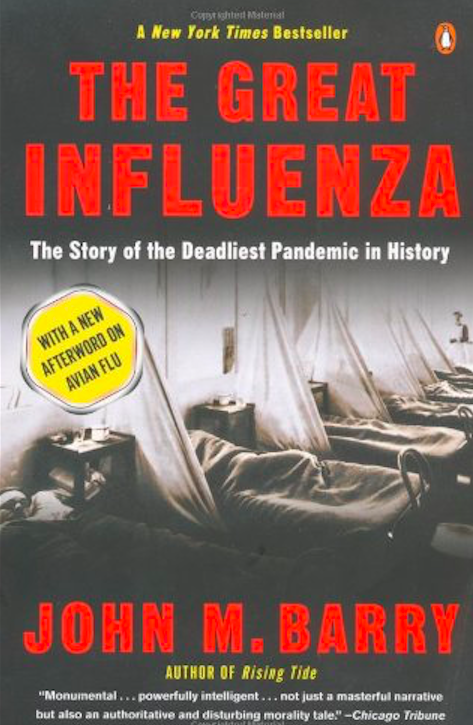aNewDomain — Trucks rolled through neighborhoods inviting people to bring out their dead—and were the only traffic left on those streets. Desperate families kidnapped nurses at gunpoint. Serious, intelligent people were calculating how much longer before civilization collapsed. Indeed, civilization suddenly seemed like a bad idea, since it encouraged people to live together—and spread deadly germs.
We’re not talking about West Africa under the current Ebola threat. We’re talking about what happened in America in 1918 when the influenza epidemic struck, as depicted in the newly relevant 11-year-old book The Great Influenza (John M. Barry, Penguin Books, 2004.)
Ebola, with a 70 percent fatality rate, is spread by direct contact with bodily fluids (we think) and we have neither cure, treatment, nor vaccine. With influenza, the death rate was “only” about five percent, but it was spread through the air, and by viruses. Medical science of 1918 knew little about viruses and kept blaming various misidentified strains of bacteria for the plague, leaving doctors impotent. Quarantining the sick didn’t work, since the victims could spread the disease two days before they showed any symptoms.
The only measure that worked was total physical isolation from the rest of society, which only a few communities were able to impose. Most locales did not have functional health departments capable of undertaking meaningful measures, and if they did the health officials often gave priority to maintaining calm, to serve the war effort. In Philadelphia they allowed a war bond parade to proceed despite dire warnings, and within 72 hours every hospital in the city was full.
The US Army, in the midst of a build-up for World War I, stopped the draft since no training was taking place at the plague-ridden army bases, which were consumed with patient care. Turned-away draftees, when they got home, had trouble getting their families to let them in the door.
Thirty thousand people died in New York City alone. In places they ran out of coffins, and then they ran out of grave diggers. Cities came to a stand-still—until, mercifully, the flu went away as suddenly and mysteriously as it had arrived.
The main lesson that surfaces is that a 70 percent fatality rate is not required to bring society to its knees—five percent suffices. Meanwhile, epidemics and politics are not a good mix, unless you consider fire and gasoline a good mix.
As for the book, be warned that it contains as much material about the history of American medicine in general, and bacteriology in particular, as it does about the flu epidemic. This material is illuminating: medical education in the U.S. had only been brought up to modern, scientific standards in 1910, and during World War I the US Army secretly gathered lists of incompetent old-school doctors so it could avoid hiring them. But the book’s lengthy coverage of the bacteriologists is painful to read, as they stumbled from defeat to defeat while about 100 million people died worldwide. The guilty virus was not identified until 1931.
Incidentally, while the 1918 plague is called the Spanish Influenza, The Great Influenza makes the case that it originated in Kansas.
For aNewDomain, I’m Lamont Wood.













